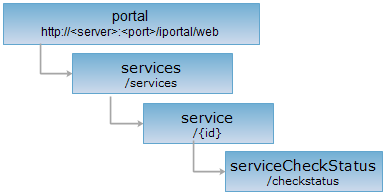URI
<service_uri>/checkstatus[.<format>]
Supported methods
Parent resource
Introduction
serviceCheckStatus resource is to update a single service checking status. Only administrator can query and update the service checking status.
Supported Methods:
- GET: Get the checking status of a single service.
- PUT: Update the checking status of a single service.
- HEAD: Check whether the serviceCheckStatus resource exists or whether it has permission to access the resource.
Supported output formats: RJSON, JSON, HTML, XML.
Resource hierarchy

HTTP request methods
Implement the HTTP request on the following URI, where supermapiportal is the server name, with rjson being the output format.
http://supermapiportal:8090/iportal/web/services/{id}/checkstatus.rjson
GET request
Get the checking status of a single service. The service checking status includes SUCCESSFUL, FAILED, UNCHECKED.
Response example
Implement the GET request on the serviceCheckStatus resource http://localhost:8090/iportal/web/services/1/checkstatus.rjson. Return rjson results:
SUCCESSFUL
PUT request
Update the checking status of a single service. The service checking status includes SUCCESSFUL, FAILED, UNCHECKED.
Request parameter
Execute PUT request for serviceCheckStatus resource. The request body is as follows:
| Name | Type | Description |
| checkStatus | CheckStatus | The checking status |
| verifyReason | String | The checking comments. |
Response structure
The response result returned is as the following:
| Field | Type | Description |
| succeed | boolean | Whether the checking status of a a single service is updated successfully or not. |
| error | Httperror | Error information. This field will not be displayed if the checking status of a single service is updated successfully. |
Response example
Execute PUT request for serviceCheckStatus resource http://localhost:8090/iportal/web/services/1/checkstatus.rjson. The request body is as follows:
{"checkStatus":FAILED,"verifyReason":null}
The response result in rjson format returned is as follows:
{ "succeed": true}
HEAD request
Asks for the response identical to the one that would correspond to a GET request, but without the response body. This is useful for retrieving meta-information written in response headers, without having to transport the entire content. The meta-information includes the media-type, content-encoding, transfer-encoding, content-length, etc.
HEAD request can be used to check if the serviceCheckStatus resource exists, or if the serviceCheckStatus resource can be accessed by clients. It can also determine if the serviceCheckStatus resource supports an output format <format> if performed on a URI with .<format> included.